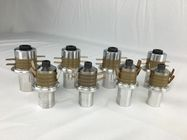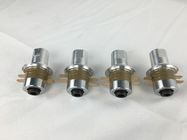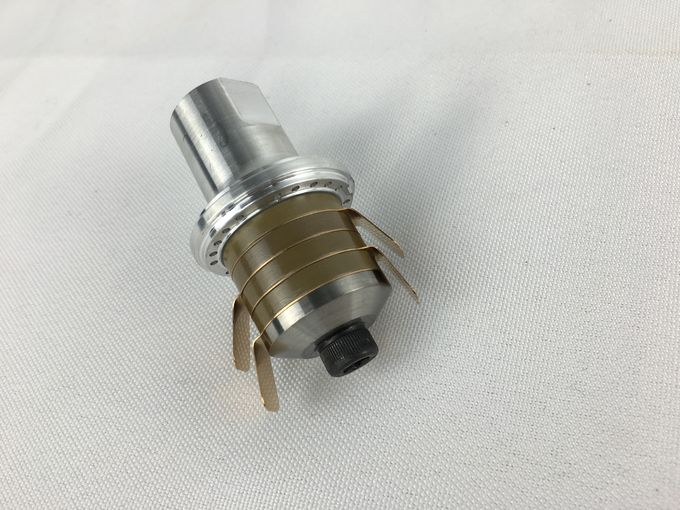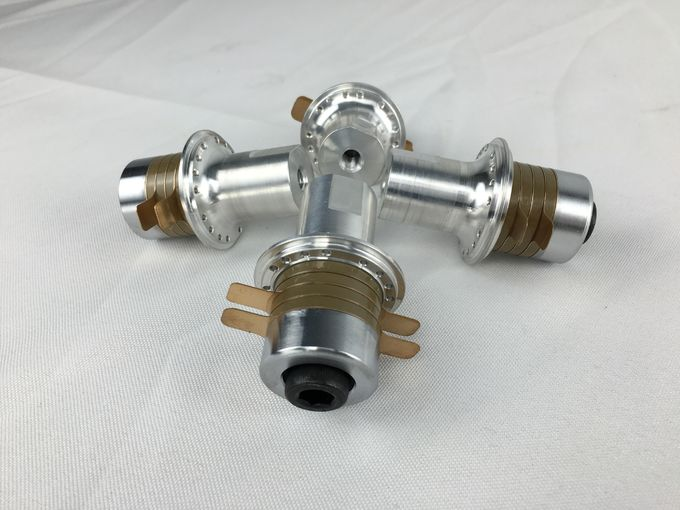
loading




| Quantity: | |
| Place of Origin | China |
|---|---|
| Brand Name | RPS-Sonic |
| Certification | CE |
| Model Number | RPS-T3030-4Z |
| Minimum Order Quantity | 5 sets |
| Price | negotiation |
| Packaging Details | Foam+Carton |
| Delivery Time | 2days |
| Payment Terms | T/T, Western Union, MoneyGram |
| Supply Ability | 200 Sets/month |
| Frequency | 30 Khz Ultrasonic Transducer | Diameter | 30mm |
|---|---|---|---|
| Ceramic Chips | 4chips | Power | 700W |
| Capacity | 6200-7200 | Application | Ultrasonic Sealing And Welding |
| Amplitude | 4um | ||
| High Light | ultrasonic power transducer,high power ultrasonic transducer | ||

A common application of ultrasonic welding is for encapsulating an object within sealed layers, such as between layers of plastic. For encapsulating an object, a horn has a welding edge which has an indentation that is greater than the object to be encapsulated. The object Is welding between plastic layers. The welding edge is then pressed against the plastic layers, receiving the object into the indentation, while the welding edge forms a seal around the object by melting together the layers.
During such a welding process, a traditional ultrasonic welding horn exposes the entire object being welded to significant amounts of ultrasonic vibration, sound energy and heat. Many objects that are sealed between plastic layers are inanimate and unaffected by such exposure. However, more sensitive objects Are not so resistant.
Ultrasonic welding has been found to be an effective and economical way. In some surgical implantation techniques, cells may be sealed between plastic layers. Such sealed cell containing devices can be placed within the body of a patient for a variety of applications including gene therapy. To seal cells within plastic layers. However, ultrasonic vibrational and sound energy from a traditional welding horn can damage or kill living cells. This damage can render the cells useless for the intended application. Thus, it has been a problem to perform an ultrasonic weld. On capsules for living tissue without harming the tissue with vibrational energy.
Alike, in other applications the vibrational energy from the ultrasonic horn can preclude ultrasonic welding as a feasible technique for creating plastic containers. For example, such is the case in creating certain medical devices that include membranes. A need, therefore, exists for an improved System and method for ultrasonic welding.
Naming method:
T - Transducer
50 - The outside diameter for piezoceramic ring (mm)
20 - The frequency of the transducer
4 - The number for piezoceramic ring,
D - The type of transducer D means Chinese type,B-Branson type,Z-NTK type.
| Power (W) | Frequency (khz) | Capacitor Range (pF) | ||
| Yellow ceramic | Gray ceramic | Black ceramic | ||
| 700 | 29.50-30.10 | -- | 6200-7200 | - |
PARAMETER
| Item No. | Connect screw (Size) | Capacitance | Input power (W) | Max. Amplitude (um) | ||
| Yellow | Grey | Black | ||||
| 3030-4Z | M10 | / | 6200-6900 | / | 700 | 4 |
| 3030-4D | M8 | / | 6200-6900 | / | 800 | 5 |
Description:
The transducer converts high-frequency electrical energy into high-frequency mechanical vibrations. And it contains several piezoelectric ceramic discs sandwiched under pressure between two metal blocks. Between each disc is a thin metal plate, which forms the electrode. When a sinusoidal electrical signal is fed to the transducer via the electrodes, the discs expand and contract, producing axial vibrations.
Transducer requirements will depend on the application. Many requirements will conflict with one another and will be given different priorities. Hence, no single set of guidelines can encompass all requirements — i.e., there are many different ways to achieve the same objectives.
Analytically, transducer performance can only be predicted in a general way. This is because the properties of piezoelectric ceramics are often highly dependent on the operating conditions including temperature, electrical field strength, static compressive prestress, dynamic stress, number of load cycles, and time. These operating conditions can interact with each other and the effects of these conditions are often nonlinear. Also, many properties of piezoelectric ceramics are orthotropic and can vary among the individual ceramics and also between ceramic lots. Further, the interactions at the various component interfaces (e.g., at threads) may be difficult to characterize and the coefficient of convective heat transfer for air cooling may only be approximately estimated. Hence, much of the design process involves experimental testing.
The transducer converts high-frequency electrical energy into high-frequency mechanical vibrations. And it contains several piezoelectric ceramic discs sandwiched under pressure between two metal blocks. Between each disc is a thin metal plate, which forms the electrode. When a sinusoidal electrical signal is fed to the transducer via the electrodes, the discs expand and contract, producing axial vibrations.
15Khz transducer widely used in high power welding&sealing system.Piezoelectric transducer is the electric charge that accumulates in certain solid materials in response to applied mechanical stress. It is key point of all ultrasonic equipment.The transducer decide the property of the machine.We can supply transducer, also transducer with house and booster.
Titanium, aluminum, steel materials of horn optional.
High efficiency: high mechanical quality factors and high efficiency of electroacoustic conversion at resonant frequency points.
Large amplitude: the structure of the computer optimized design, the ratio of vibration and speed is high, and the amplitude of the front cover plate is large.
Big power: under the action of the pre-stressed screw, the energy of the piezoelectric ceramic is exerted to the maximum extent.
Good heat resistance: small resonant impedance, small calorific value, wide range of use temperature. High reliability and long life.
One by one testing to ensure that each transducer performance are excellent.

| Frequency | 30 Khz Ultrasonic Transducer | Diameter | 30mm |
|---|---|---|---|
| Ceramic Chips | 4chips | Power | 700W |
| Capacity | 6200-7200 | Application | Ultrasonic Sealing And Welding |
| Amplitude | 4um | ||
| High Light | ultrasonic power transducer,high power ultrasonic transducer | ||

A common application of ultrasonic welding is for encapsulating an object within sealed layers, such as between layers of plastic. For encapsulating an object, a horn has a welding edge which has an indentation that is greater than the object to be encapsulated. The object Is welding between plastic layers. The welding edge is then pressed against the plastic layers, receiving the object into the indentation, while the welding edge forms a seal around the object by melting together the layers.
During such a welding process, a traditional ultrasonic welding horn exposes the entire object being welded to significant amounts of ultrasonic vibration, sound energy and heat. Many objects that are sealed between plastic layers are inanimate and unaffected by such exposure. However, more sensitive objects Are not so resistant.
Ultrasonic welding has been found to be an effective and economical way. In some surgical implantation techniques, cells may be sealed between plastic layers. Such sealed cell containing devices can be placed within the body of a patient for a variety of applications including gene therapy. To seal cells within plastic layers. However, ultrasonic vibrational and sound energy from a traditional welding horn can damage or kill living cells. This damage can render the cells useless for the intended application. Thus, it has been a problem to perform an ultrasonic weld. On capsules for living tissue without harming the tissue with vibrational energy.
Alike, in other applications the vibrational energy from the ultrasonic horn can preclude ultrasonic welding as a feasible technique for creating plastic containers. For example, such is the case in creating certain medical devices that include membranes. A need, therefore, exists for an improved System and method for ultrasonic welding.
Naming method:
T - Transducer
50 - The outside diameter for piezoceramic ring (mm)
20 - The frequency of the transducer
4 - The number for piezoceramic ring,
D - The type of transducer D means Chinese type,B-Branson type,Z-NTK type.
| Power (W) | Frequency (khz) | Capacitor Range (pF) | ||
| Yellow ceramic | Gray ceramic | Black ceramic | ||
| 700 | 29.50-30.10 | -- | 6200-7200 | - |
PARAMETER
| Item No. | Connect screw (Size) | Capacitance | Input power (W) | Max. Amplitude (um) | ||
| Yellow | Grey | Black | ||||
| 3030-4Z | M10 | / | 6200-6900 | / | 700 | 4 |
| 3030-4D | M8 | / | 6200-6900 | / | 800 | 5 |
Description:
The transducer converts high-frequency electrical energy into high-frequency mechanical vibrations. And it contains several piezoelectric ceramic discs sandwiched under pressure between two metal blocks. Between each disc is a thin metal plate, which forms the electrode. When a sinusoidal electrical signal is fed to the transducer via the electrodes, the discs expand and contract, producing axial vibrations.
Transducer requirements will depend on the application. Many requirements will conflict with one another and will be given different priorities. Hence, no single set of guidelines can encompass all requirements — i.e., there are many different ways to achieve the same objectives.
Analytically, transducer performance can only be predicted in a general way. This is because the properties of piezoelectric ceramics are often highly dependent on the operating conditions including temperature, electrical field strength, static compressive prestress, dynamic stress, number of load cycles, and time. These operating conditions can interact with each other and the effects of these conditions are often nonlinear. Also, many properties of piezoelectric ceramics are orthotropic and can vary among the individual ceramics and also between ceramic lots. Further, the interactions at the various component interfaces (e.g., at threads) may be difficult to characterize and the coefficient of convective heat transfer for air cooling may only be approximately estimated. Hence, much of the design process involves experimental testing.
The transducer converts high-frequency electrical energy into high-frequency mechanical vibrations. And it contains several piezoelectric ceramic discs sandwiched under pressure between two metal blocks. Between each disc is a thin metal plate, which forms the electrode. When a sinusoidal electrical signal is fed to the transducer via the electrodes, the discs expand and contract, producing axial vibrations.
15Khz transducer widely used in high power welding&sealing system.Piezoelectric transducer is the electric charge that accumulates in certain solid materials in response to applied mechanical stress. It is key point of all ultrasonic equipment.The transducer decide the property of the machine.We can supply transducer, also transducer with house and booster.
Titanium, aluminum, steel materials of horn optional.
High efficiency: high mechanical quality factors and high efficiency of electroacoustic conversion at resonant frequency points.
Large amplitude: the structure of the computer optimized design, the ratio of vibration and speed is high, and the amplitude of the front cover plate is large.
Big power: under the action of the pre-stressed screw, the energy of the piezoelectric ceramic is exerted to the maximum extent.
Good heat resistance: small resonant impedance, small calorific value, wide range of use temperature. High reliability and long life.
One by one testing to ensure that each transducer performance are excellent.









Ultrasonic Welding Equipment Ultrasonic Welding Transducer Ultrasonic Welding Converter Ultrasonic Liquid Processor Ultrasonic Cutting Equipment Ultrasonic Spray Nozzles Ultrasonic Power Supply Ultrasonic Soldering Equipment Ultrasonic Welding Horn Ultrasonic Assisted Machining Ultrasonic Testing Equipment
content is empty!